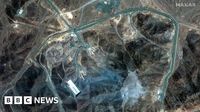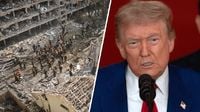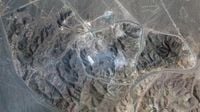In a dramatic escalation of the ongoing conflict between Israel and Iran, the United States launched a series of precision strikes on Iran’s nuclear facilities over the weekend of June 21-22, 2025. President Donald Trump announced the operation, codenamed Midnight Hammer, which targeted three key nuclear sites: Fordo, Natanz, and Isfahan. This marked a significant shift as the U.S. inserted itself directly into a war it had long sought to avoid, raising urgent questions about the future of Iran’s nuclear program and the potential for a wider regional conflict.
According to U.S. military officials, the operation involved 125 aircraft and 75 precision-guided weapons, including 14 Massive Ordnance Penetrators (MOPs)—the massive 30,000-pound bunker-buster bombs uniquely operated by the U.S.—which were dropped on the Fordo site. Fordo is a deeply buried uranium enrichment facility located beneath a mountain outside Tehran, making it a critical part of Iran’s nuclear ambitions. The strikes were executed with stealth B-2 bombers and submarine-launched cruise missiles, showcasing a complex and carefully planned military campaign.
President Trump hailed the strikes as “a spectacular military success” and claimed that Iran’s key nuclear enrichment facilities had been “completely and totally obliterated.” He warned that if Iran did not come to the negotiating table, future attacks would be “far greater,” stating, “Remember, there are many targets left.” However, Pentagon officials later tempered this rhetoric, acknowledging that the full extent of the damage and the amount of Iran’s remaining nuclear stockpile were still under assessment.
Satellite imagery analyzed by experts revealed six fresh craters at the Fordo site, consistent with the impact of the bunker-buster bombs. However, analysts noted that the bombs are designed to detonate deep underground, so visible surface damage is limited. Iranian officials claimed that the targeted sites had been evacuated prior to the strikes and insisted that Iran did not suffer a major blow. The Atomic Energy Organization of Iran condemned the attacks as a “barbaric violation” of international law, yet both Iran and the U.N. nuclear watchdog reported no immediate signs of radioactive contamination.
The U.S. strikes came amid an ongoing air war between Israel and Iran, which erupted earlier in June 2025 after Israel launched surprise attacks on Iranian nuclear and military targets. Israeli Prime Minister Benjamin Netanyahu praised Trump’s decision, calling it a move that “will change history.” Israeli military officials stated they were close to achieving their objectives in neutralizing Iran’s nuclear and missile threats, but acknowledged that further strikes were planned.
Iran responded swiftly, launching a barrage of missiles at Israeli cities including Tel Aviv and Haifa, injuring over 80 people. The conflict has already resulted in hundreds of casualties on both sides, with at least 950 killed in Iran and 24 in Israel. Iran’s paramilitary Revolutionary Guard also targeted U.S. military bases in the region, including a missile attack on the Al Udeid Air Base in Qatar, a major hub for American forces. Fortunately, the missiles were intercepted and no casualties were reported.
The escalating tensions have raised concerns globally. Oil prices surged as markets reacted to fears of disruption in the strategically vital Strait of Hormuz, through which about 20 million barrels of oil per day transit. Experts warned that any attempt by Iran to close this chokepoint could trigger an inflationary shock worldwide, though many expect the U.S. Navy would quickly intervene to keep the strait open.
On Capitol Hill, President Trump’s unilateral military action faced bipartisan pushback. Several lawmakers argued the strike was unconstitutional, bypassing Congress’s authority to declare war. Republican Representative Thomas Massie and Democratic Representative Ro Khanna introduced a War Powers Resolution to prohibit unauthorized hostilities against Iran, with Democratic Senator Tim Kaine leading a similar effort in the Senate. They contended there was no imminent threat justifying the strike without congressional approval, emphasizing the need for debate and oversight.
House Minority Leader Hakeem Jeffries expressed skepticism about the strike’s justification, stating, “We’ve seen no evidence to date that an offensive strike of this nature was justified under the War Powers Act or the Constitution.” In contrast, House Speaker Mike Johnson dismissed calls for a war powers resolution as unnecessary, underscoring the president’s authority as commander in chief to act against imminent threats.
Vice President J.D. Vance defended the strikes, framing the conflict as a war against Iran’s nuclear program rather than the country itself. “We’re not at war with Iran,” he said. “We’re at war with Iran’s nuclear program.” Vance praised the American military’s execution of the operation and asserted that the intervention would not be prolonged, promising efforts to dismantle the nuclear program over coming years.
Yet, this stance has drawn criticism for contradicting Trump’s earlier campaign promises to avoid foreign entanglements. Critics point to the long history of U.S. military interventions in the Middle East that have often led to drawn-out conflicts. Observers urge caution, noting that military action without clear congressional authorization risks entangling the U.S. in another protracted war.
The legal justification for the strikes partly rests on the 1973 War Powers Resolution, which requires the president to notify Congress within 48 hours of introducing armed forces into hostilities and limits such engagements to 60 days without congressional approval. Defense Secretary Pete Hegseth claimed the administration complied with notification requirements, informing Congress after the operation was underway. Additionally, the administration may cite the 2001 and 2002 Authorizations for Use of Military Force (AUMF), which have been broadly interpreted to permit military actions against terrorist threats and in Iraq, respectively.
As the dust settles, diplomatic efforts are underway to prevent further escalation. On June 23, 2025, President Trump announced a ceasefire between Iran and Israel, brokered with Qatar’s mediation. Iran’s state media confirmed the agreement, though Israel had yet to officially comment. The ceasefire reportedly hinges on Iran halting its attacks on Israel, a condition to which Iran agreed.
Despite the ceasefire, fresh missile attacks were reported early on June 24, including one that struck a residential building in southern Israel, killing three. Iranian state media also reported Israeli strikes on Tehran overnight. The continued tit-for-tat violence underscores the fragility of the ceasefire and the volatility of the region.
Globally, reactions have been mixed. Western allies like the UK, France, and Germany urged Iran to engage in diplomatic talks, while the United Nations called the U.S. strikes a dangerous escalation. Russia condemned the attacks as violations of international law. Gulf nations called for de-escalation, wary of the broader repercussions for regional stability.
With the U.S. now directly involved in the Israel-Iran conflict, the stakes have never been higher. The operation’s success could curtail Iran’s nuclear ambitions and enhance Israel’s security, but miscalculations risk drawing the U.S. into a prolonged and unpredictable war. The coming days will be critical as leaders weigh diplomacy against the threat of further military action, with the world watching closely.



